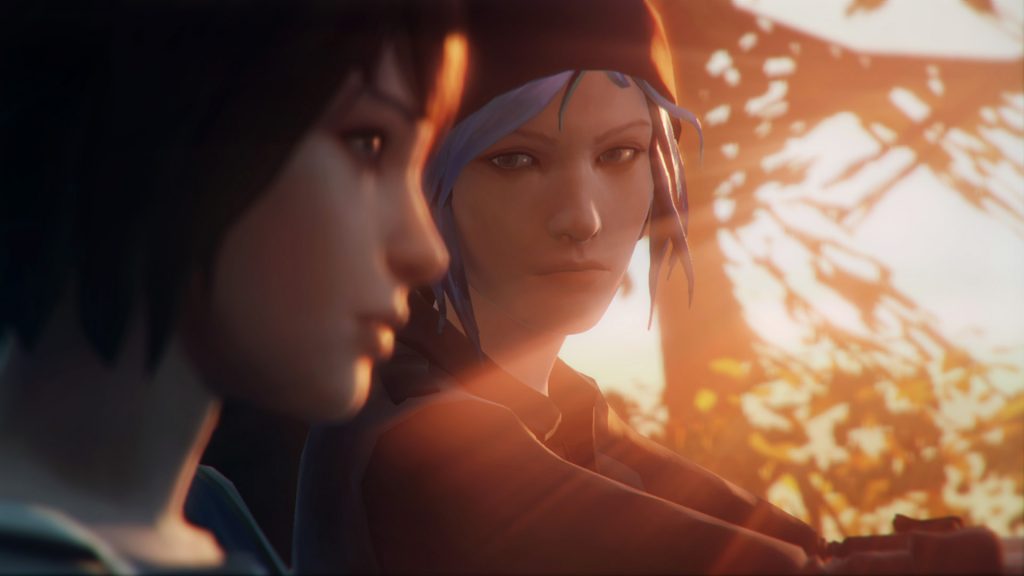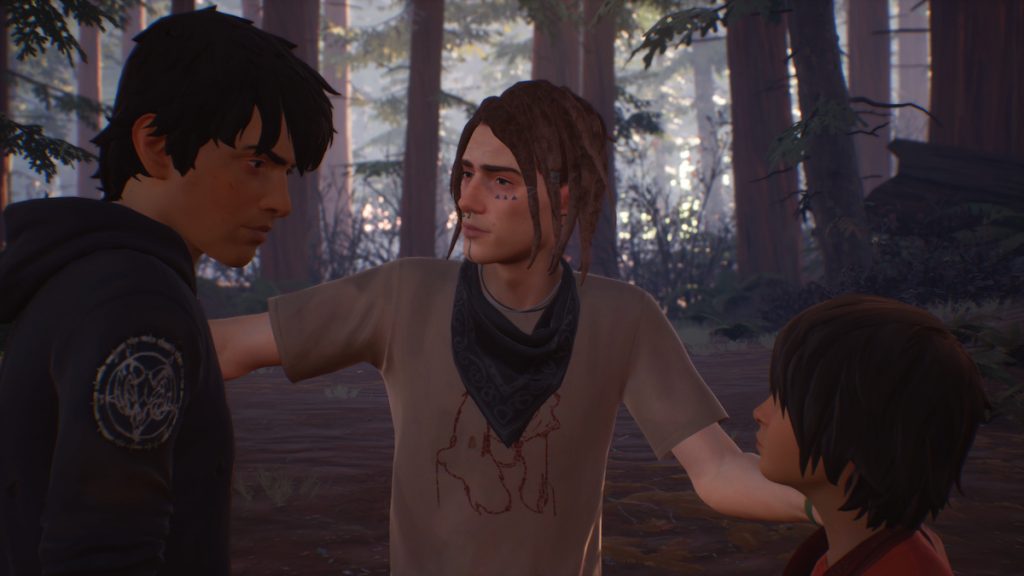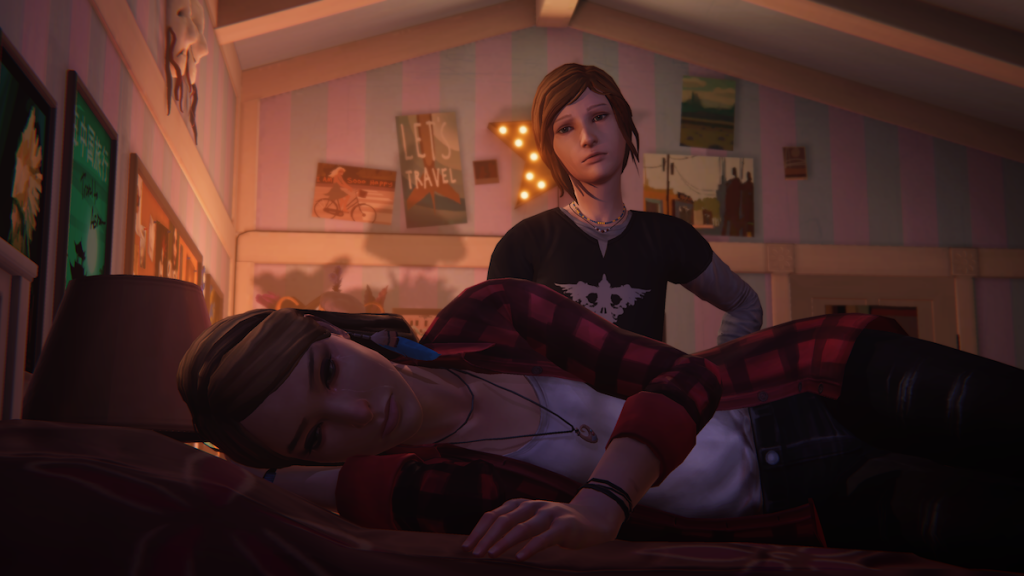
Life is Strange has yet to portray a healthy queer relationship
Life is Strange has an understanding of how delicate the self-discovery process can be for queer youth. The first time Max Caufield is able to express romantic interest in a woman in the original game, it’s her best friend Chloe Price, playfully flirting with no pressure. Rewind to a year prior in the prequel Life is Strange: Before the Storm and Chloe was telling Rachel Amber, her new friend and kindred spirit, that she felt a connection to her beyond friendship. Fast forward to now, in the third episode of Life is Strange 2, Sean Diaz is able to explore his own bisexuality in a group of drifters open to discussing and dreaming about the human experience.
Life is Strange isn’t a happy series, and Dontnod and Deck Nine have found ways to weave their protagonists’ queerness into the few safe spaces it has. But once one of its same-sex relationships is established it succumbs to the same rot so many other characters and stories it tells, to the point where despite all the care put into its self-discovery stories, Life is Strange has yet to portray a healthy queer relationship. Each of them are riddled in their own brands of toxicity, manipulation, and harmful tropes not found in their opposite-sex equivalents.
This finally occurred to me while playing Life is Strange 2’s third episode. Sean Diaz, having been on the run with his brother Daniel from police in Seattle for months, meets a boy named Finn, who is a pseudo leader of a group of drifters working in illegal cannabis trade. The two connect over their found family, run ins with the law, and a general distaste for authority. Both of them are looking for a better life for themselves, and Finn is more than supportive of Sean’s goal to get his brother to Mexico. But to solidify a relationship with Finn, Sean has to put his little brother in harm’s way.

After Finn finds out Daniel has telekinetic powers, he concocts a plan to break in to the cannabis supplier’s office and take a lump sum of cash, all while putting each of them at risk. If Sean doesn’t choose to go along with the plan, he and Finn never reach a point of intimacy, and his hypothetical boyfriend ends up going behind his back anyway. Finn’s relationship with Sean has moments of genuine connection, but no matter what route the player takes, it always comes second to his ambition. There are several ways the end of the episode can play out, but no one leaves unscathed.
Finn is the most recent example of Life is Strange’s destructive queer relationships, but his opposite-sex counterpart, Cassidy, another member of the drifters, is not only one of the healthiest depictions of fleeting teen romance in the series, it features some of the most sophisticated writing of love and sex a game has had since games like Dragon Age: Inquisition’s depiction of BDSM and queer shame. This is best captured by the sex scene between her and Sean, which is awkward, a little messy, but doubles down on the importance of consent, trust, and making sure an inexperienced partner is comfortable at all times.
The imbalance in communication and power between Life is Strange’s same-sex relationships vs. its opposite-sex ones has been a trend for the series since the original game. Max Caulfield, the time-traveling photographer of the first game, has two possible love interests over the course of five episodes. Warren, one of Max’s classmates, is a recklessly loyal friend, who, more than once defends Max from the immediate danger of noted drug dealer Nathan Prescott, and also a potential boyfriend for Max. Their relationship isn’t quite as constant as the other option, but when it’s there Warren is supportive and understanding of a lot of the absurdity Max puts him through.
Conversely, Chloe Price is a complicated individual and her potential relationship with Max comes with baggage. The two were best friends who drifted apart, finally coming back together during the course of the game, but the time they weren’t together creates rifts that affect Max’s ability to have relationships and priorities that don’t involve Chloe. In one episode, one of the major choices the game presents the player with is whether or not to answer a call from a depressed friend while hanging out with Chloe, diverting your attention away from her, all culminating in the two not leaving a diner in time to avoid a fight between Chloe and her mother.

Early on, Life is Strange establishes what Max’s priorities have to be in order to remain on good terms, which means Chloe’s wants and desires come before anyone else’s. Later, Chloe can berate Max for being unwilling to shoot someone, and throughout their relationship there are guilt trips given for their drifting apart. Chloe and Max’s relationship is an incredibly nuanced and dynamic one, and it has moments of redemption and reconciliation, but the getting there is a minefield of manipulation and guilt to walk through to get there.
Perhaps the most complicated of all is the relationship between Chloe and Rachel Amber. While the two girls’ relationship is kept ambiguous in the original game, the prequel, Life is Strange: Before the Storm allows the player to define it as romantic or platonic. A platonic relationship colors the events of the first game in one way, while their relationship viewed as love between two young, queer women, the discoveries Chloe learns about her partner are tinged with a level of betrayal that the other queer relationships in Life is Strange don’t even come close to.

Before the Storm opts to not touch on the worst parts of Chloe and Rachel’s relationship, where it is an earnest attraction from the girl’s desire to leave their hometown and run away together. This attempt to only explore the best period of their relationship actually gives them something that resembles a happy ending, at least as far as the prequel goes. However, when Chloe and Max investigate her disappearance in Life is Strange proper, they discover she was carrying on a relationship with a local drug dealer, then began an affair with her photography professor, a relationship that ultimately led to her untimely death. The nature of the latter affair is left ambiguous, as it is relayed by the professor, who at this point has been established as a villain, thus an unreliable narrator, but whatever it was, everything about Rachel’s relationship with Chloe comes into question.
So much of Life is Strange’s exploration of the life of a modern day teenager, even with its supernatural twists, is delivered with a sincerity that has helped so many people connect with its characters, even with all the melodrama that comes with it. It’s why all its care put into the self-discovery of its queer protagonists is as affecting as it is. I just hope, maybe in Life is Strange 3, the safe space for its queer characters doesn’t lead them into a trap next time.








It has been actually confirmed that Rachel did fall in love with Jefferson. Personally, I think it was always strongly implied that Rachel was very manipulative in her own subtle way, which is shown in BtS (drugging Victoria, etc), but Chloe simply refused realize that her relationship with Rachel was unhealthy because Rachel was “her angel”.
However, I think it’s important that Life is Strange avoided even a bigger trap by not portraying lgbt relationships as perfect and happy. Big problems like manipulation, guilt, lying, betrayals and emotional abuse are also part of lgbt relationships every day just like they are part of heterosexual relationships.
Moreover, l do not think there was the imbalance in communication and power between same-sex relationships vs. its opposite-sex ones. Because it’s quite clear that the first game established Chloe as this more interesting and attractive alternative for Max/players than Warren ever was. And unlike the first game, mostvof the time Before the Storm doesn’t even give player an option to be more snarky towards Rachel or even criticize her manipulative, toxic behaviour, and the entire gameplay is not half as rewarding if you only want Chloe and Rachel to be good friends instead of lovers.